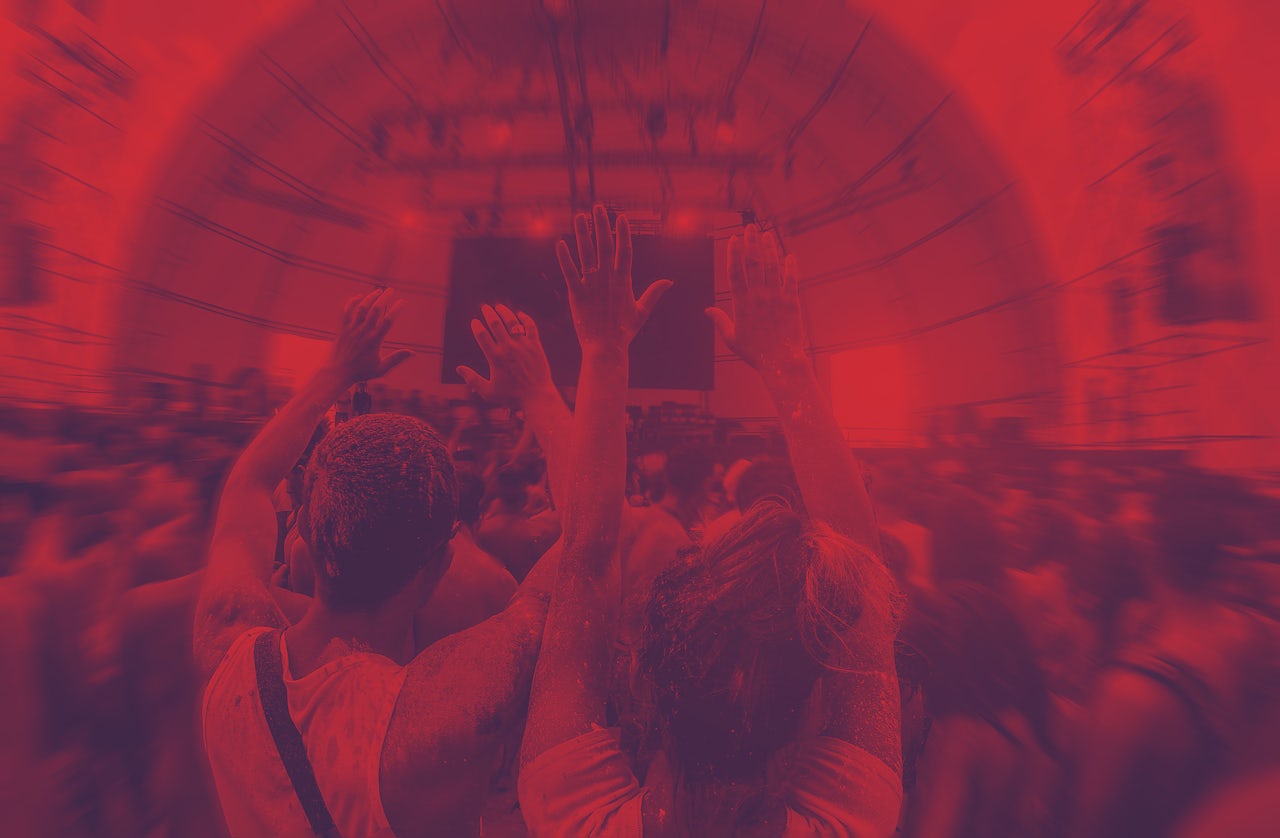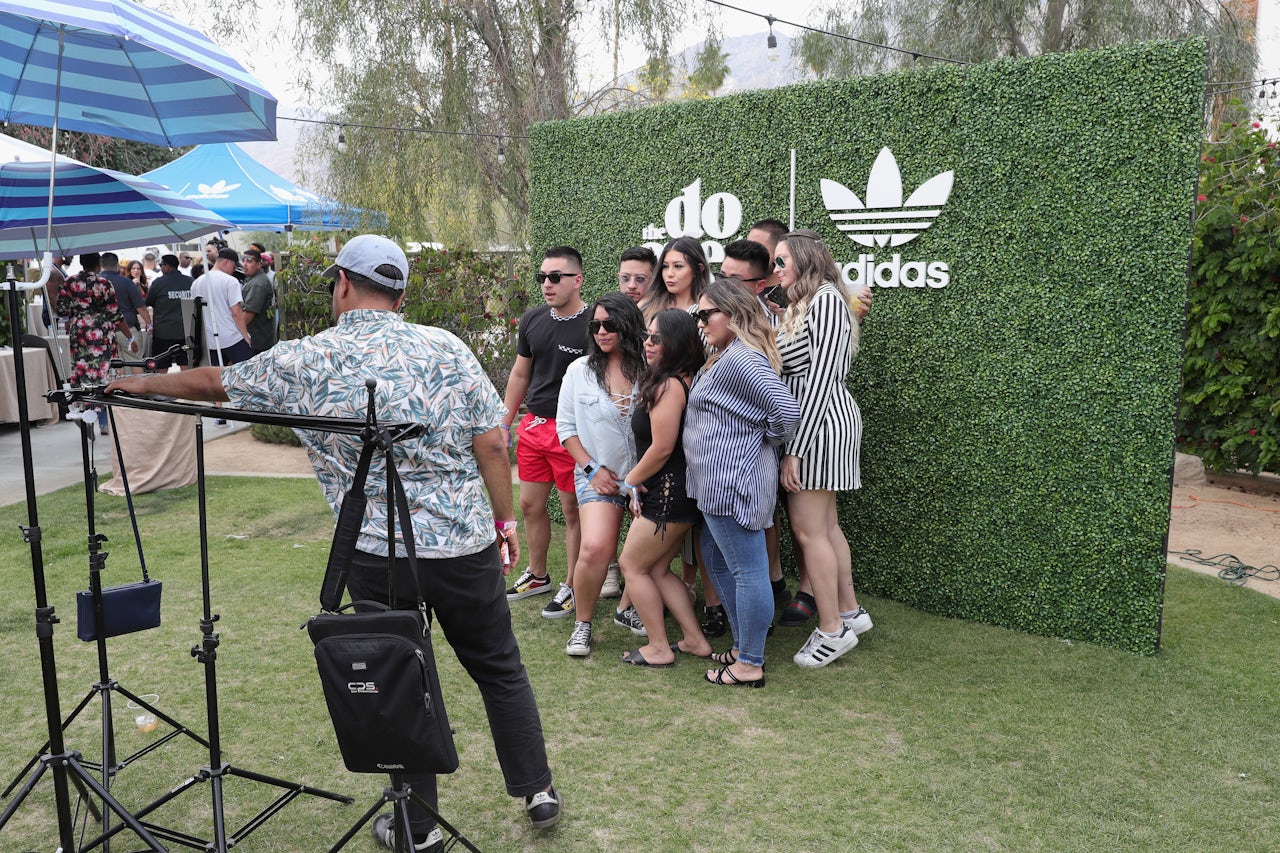You’re nineteen years old and you’re at Coachella, the sickest festival there is. Surrounded by palm trees and babes, your worries melt away. You don a rhinestone bra and smoke blunts with abandon. You share freely with strangers, and others share with you. It’s liberating. Having left “the real world,” you find it bitter by comparison; why aren’t we always this happy, so wild and free? When Beyoncé performs, you transcend your human body. The crowd becomes one, and you think you’ve found utopia.
The next day’s not so easy. It’s 108 degrees, and you’re hungover from the molly. Your friend spends the day in the med tent, dehydrated. You’re not quite ready for more EDM, but your crew wants to see Major Lazer. Bros are brandishing American flags above a crowd of ten-thousand that fist pumps in unison. Diplo commands you to “make that fucking booty shake.” Then he tells the crowd to “put your lasers in the air” and everyone thrusts gun-shaped hands toward the sky. You’re pulled out of the moment by an unsettling thought: Why is this everything but relaxing?
Millennials wear flower crowns and tie-dye to Coachella, but only the biggest Lana Del Rey stans would think it’s anything like Woodstock. Festivals once offered spiritual release, but like so many things, they have been co-opted, and repurposed by corporations and the state. Festivals today promote brands and war through marketing, surveillance, and subtle propaganda. Consumers, effectively, are buying tickets to their own subjugation.
Festivals have been around for thousands of years. To celebrate Dionysus, god of fertility and madness, the ancient Greeks held Bacchanalia, which drew revelers beyond the city walls to drink and dance for days on end to trance-inducing drumbeats. The largest Roman festival was Saturnalia, an entire week of partying and gift-giving, held at the end of December. Saturn, god of wealth and time, was closely associated with the government of Rome, and Saturnalia was a public holiday. The freedom from work and social norms was seen as a gift from the state.
Then, the Romans went Catholic, converting many of their conquered subjects. Throughout the West, pagan festivals like Beltane and Ostara were suppressed or merged into Christian traditions. Festivals became less orgiastic: by the time the Puritans colonized North America, Saturnalia had long-since become Christmas, and Dionysus was seen as an archaic wine god, rather than a spirit that led people into ecstasy.
“From the moment you step into the venue we know where you are.”
Pre-Lenten festivals, like the Carnival of Venice, gave Christians a chance to gorge and sin before they started fasting for Lent. (This is how Mardi Gras, or “Fat Tuesday,” got its name.) In the Americas, these holidays blended with African and indigenous traditions, creating colorful events like Brazil’s Carnival and the Mardi Gras of New Orleans. Costumes, music, drinking, and dancing came to define this festive season, which was sanctioned by church and state.
“The energy that was buried with the rise of the Christian nations must come back into the world; nothing can prevent it,” James Baldwin wrote in 1963’s The Fire Next Time. Six years later, there was Woodstock. 400,000 people converged on an ill-prepared farm in upstate New York in an outburst of hedonistic impulse. Participants ditched their clothes and rolled in mud-pits on acid, as artists like Janis Joplin and Jimi Hendrix played genre-defining sets. It was the birth of the festival as we know it, with bohemian campgrounds and a star-studded lineup. But Woodstock recedes from our present like a myth. The fenceless anarchy, which made it so special, nearly bankrupted its creators.
The festival changed over time. Woodstock was revived in 1994, but was once again plagued by security issues. The next incarnation, Woodstock ‘99, was held on a hot tarmac, with few trees for shade. Guards confiscated water bottles and food, forcing attendees to buy from overpriced booths. This fostered unrest, which led to violence and riots. The plywood fences burned, and a number of women were raped before state troopers forced everyone to leave. An MTV host who attended the festival compared it to a concentration camp, and The San Francisco Chronicle called it “the day the music died.”
It was also in ‘99 that Coachella began. Heralded as the “anti-Woodstock 99”, it was formed as an indie alternative to a touring circuit dominated by Ticketmaster. Only 25,000 people attended, and the promoters took a huge loss. Five years later, it swelled to a sellout crowd of 110,000 and was purchased by a conglomerate called AEG Live, which owns several major arenas. Coachella could now afford to book much bigger names, at the expense of its independent spirit.
Over the next decade, festivals boomed, from Bonnaroo to Sasquatch to Lollapalooza. Live Nation, another conglomerate, now owns all of these and more, over 60 festivals in total. Consolidation has led to standardization. Instead of local flair and flavor, festivals from coast to coast now have similar line-ups and sponsors. To maximize profit and minimize risk, security grows ever tighter.
To enter Coachella, you must wear a wristband that contains a trackable chip. "From the moment you step into the venue we know where you are,” a spokesman for the local police told The Desert Sun. The perimeter fence is patrolled by guards and dotted with checkpoints, like a border. Other festivals scan people’s faces in the crowd and station police in SkyCop towers. Drones have become common in festival skies, and Coachella now uses them for surveillance, too.
These measures keep us trapped in the fest, a concentrated zone of consumption. You have no choice but to buy from the vendors, to watch artists perform beneath logos. As temperatures soar over 100 degrees, sponsored activities are tied to survival: Cool off in the Heineken igloo! Skip the water lines by liking H&M on Facebook!
Of course, the music is different now, too. Jam bands and rock stars are on their way out, as hip hop artists and DJs take top billing at Coachella. At a rock concert, folks might sing along, put their lighters in the air, or slow dance with a loved one. An EDM set is much more visceral. The bass pounds hard and fast, willing us to dance at a prescribed beats per minute. We get tense with build-up, and release with each drop, as if on a rollercoaster that the DJ controls. The festival stage is surrounded by logos, and behind the DJ are screens displaying visuals, which tend to be abstract: kaleidoscopes or undulating landscapes.
Some artists go ahead and use visuals that eerily resemble propaganda. Flume’s visuals have featured fighter pilots and missiles. RL Grime has centered predator drones and tanks. The two guys in Flosstradamus play in military fatigues, backed by revolving Blackhawk helicopters. Major Lazer’s entire brand turns on appropriative militarism. Their last album claimed that “Peace is the Mission,” which sounds like something an Army General might say.
It may not surprise anyone that Coachella isn’t radical. Hippies were celebrating the dawn of a “New Age,” but millenials are more pragmatic. The majority of young people today oppose capitalism, but many of us, especially those that attend Coachella, have also learned to embrace it ironically. We tag sponsored content and tweet back at brands; even the socialists dabble in commerce.
It’s hard to imagine other ways of existing — yet this is exactly what festivals could help us do. The ones that resist commodification serve as labs of human experience. Though it is also a playground for the rich, Burning Man is a monument to what people can create, from the ground-up, with communitarian ethics. European teknivals are free to attend, and are often anarchist in nature. Transformational gatherings like Symbiosis focus on sustainability, in the absence of screens or ads. Their intention is to create environments that promote “values of community and social justice.”
Such events are far from perfect – utopia literally means “no place” – but unlike Coachella, they at least attempt to envision something beyond “who’s headlining?” In the context of a land scarred by colonization, in a time when climate catastrophe looms, mainstream festivals reinforce the systems that have brought the earth to her knees. Raving beneath American flags, as bombs explode on screen, kids are finding ecstasy in symbolic displays of unconscionable violence. It certainly isn’t sustainable, and the comedown must be brutal.

